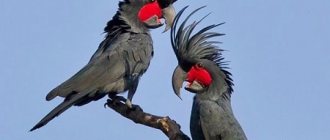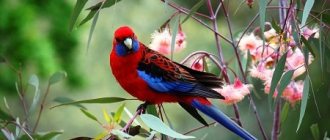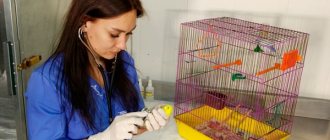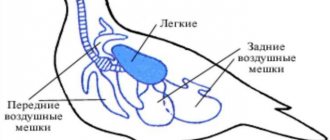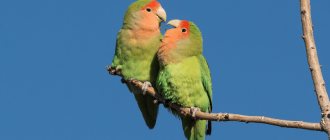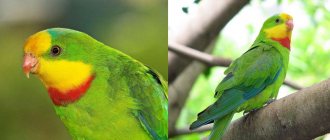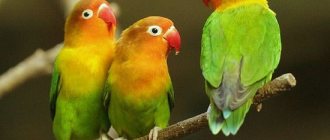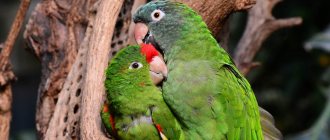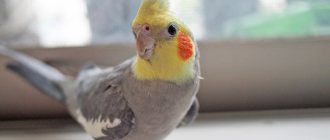The genus of lovebirds is called Agapornis in Latin, meaning “loving birds.” The British call them Love Birds. There are 9 known species of lovebirds. The Masked Lovebird (Agapornis personatus, Yellow-collared Lovebird) is the most beautiful of them all. It is listed in the Red Book, but for many years the population size of these birds has remained unchanged.
These parrots came to Europe only in the 20s of the 20th century. The cheerful and sociable sparrow-sized birds were readily kept as pets. Lovebirds live in captivity for about 15 years. Unfortunately, it is almost impossible to teach them to talk. Parrots are able to learn a few words, but pronounce them with terrible pronunciation.
Description of the species
The first description of masked lovebirds was made in 1887 by the German ornithologist Anton Reichenow. A small bird weighs about 50 grams. The body length is 15 cm, the tail is short, only 4 cm. The color of the plumage is predominantly green - this is how the belly, back, tail and wings are colored. The tips of the feathers are dark blue. The breast, nape and neck are orange-yellow.
The large head is decorated with a dark “mask” and a bright red, large, strong beak. The eyes are large and brown. There are white “leather glasses” around the eyes. Paws are gray.
Chicks have light colored feathers. After each molt, the birds change their clothing to a brighter one. It is practically impossible to distinguish a female from a male visually. The color of the “mask” may differ slightly - in the male it is darker. To accurately determine gender, it is necessary to do a blood or stool test.
How to choose a chick
To purchase a healthy masked lovebird, you need to go not to a bird market or a pet store, but to a specialized nursery. Before making your final choice, you should ask:
- conditions of keeping parents and chicks;
- behavioral characteristics;
- availability of accompanying documents.
You also need to pay attention to the appearance of the chick you like. A healthy masked lovebird should have:
- uniformly colored paws;
- clear eyes;
- smooth, close-fitting feathers;
- curved, strong, symmetrical beak;
- glossy claws;
- noticeable fat layer in the abdominal area.
Important! You should not buy a too thin, passively sitting chick with a hoarse voice, cloudy eyes, sticky feathers and bald spots on the body.
The Masked Lovebird is a temperamental parrot with a loud voice and a bright, characteristic color. It easily adapts to captivity and lends itself well to taming.
Habitats
The homeland of masked lovebirds is Africa. They inhabit the central part of Tanzania and the northeastern regions of Kenya, not rising above 1400 m above sea level. Birds live in savannas near a water source, preferring acacia groves.
Parrots live in small flocks of 25–40 individuals. They spend the night in trees or bushes. They feed on fruits, plants and seeds.
Parrots nest in tree hollows; the female is responsible for arranging the nest. This process can take two weeks; the parrot brings twigs in its beak.
Usually there are from 4 to 6 eggs in a clutch, chicks appear after 3 to 4 weeks. They are covered with pinkish fluff; the eyes open on the 10th day. They are ready to fly out of the nest at 35-40 days.
Cell selection
At a minimum, you will need a cage at least one meter wide, long and high. If it is possible to install a larger cage, pay more attention to the length than the height. Thanks to this, the parrot will be able to spread its wings and even fly inside the home.
The distance between the bars should be no more than 1-1.5 centimeters and oriented horizontally so that the birds can climb up the sides of the cage. Avoid round cages as they are more likely to damage the tail feathers. Provide a variety of sizes and types of perches, including tree branches, so your pet has options.
Content
Lovebirds are usually kept in pairs. If you do not want to keep two birds, you can buy one masked lovebird, female or male. You need to pay a little more attention to him, and the bird will not feel the lack of a companion.
Lovebirds are noisy birds. They make loud, booming trills and shrill sounds. A sleeping parrot quietly creaks its beak.
Cell
These active birds need a large cage, at least 60x40x50 cm. Birds love to climb horizontal bars, so it should be longer than tall.
The cage must be regularly cleared of food and droppings. Cleaning takes 10-15 minutes every day. In winter, it is recommended to illuminate the parrot's home with daylight.
Pay attention to the distance between the rods - it should not exceed 1.5 cm. An inquisitive bird will try to stick its head outside the cage and may get hurt.
The parrot's home must be made of durable material, otherwise the owner of a strong beak will quickly render it unusable. It is advisable to place wooden perches in a place opposite to the feeder and drinking bowl. Their thickness should be approximately 1.5 cm so that the parrot's legs can grasp them.
Toys, walks and water treatments
There is no need to clutter the cage with toys; birds need free space. Parrots love to swing on swings and climb ladders. Be sure to hang a mirror for the lonely lovebird. He will talk to his reflection, and at night lean against the mirror as his partner.
The parrot loves to swim. For drinking and bathing, you can place a large bowl of water in the cage.
A parrot must fly every day. You can leave the cage door open so that your pet can get out and fly around the room. Remove all objects that could injure the bird and close the windows. A bowl filled with food will lure the parrot back into the cage.
At night, the cage is covered with a blanket so that the parrot calms down and falls asleep. If the lovebird is alone, play and communicate with him more often, pay more attention to the parrot.
Domestication
As is clear from the name - lovebird, this species prefers to live in pairs. Therefore, having chosen a parrot of this species as your pet, you should think about getting him a friend with whom he would spend his free time. Otherwise, you will have to act as this friend, giving the bird as much of your attention as possible.
It just so happens that these freedom-loving birds value freedom and the presence of large space. In this connection, it will be necessary to think about purchasing a large and spacious cage. Moreover, it will be very good if pots with plants are installed next to the cage, creating an imitation of living nature for the parrot.
A cage purchased for a parrot should not be overcrowded with all sorts of toys to pamper your pet. The fact is that with a lot of clutter in the living space, the parrot will move less and the threat of obesity looms. In this connection, you should try to keep the cage always open, giving the parrot the opportunity to get out of it and fly around the room, stretching its wings.
However, do not underestimate this feathered prankster. The lovebird has a fairly strong beak, which can easily damage any of the surfaces that interest it, be it the wooden parts of the cage interior or things in the room.
Lighting is also an important factor. Since this bird is a freedom-loving bird, in addition to a large spacious cage, it will be necessary to take care of the lighting. Therefore, it is advisable to place the cage near a window or some other light source.
In addition, the cage chosen for this parrot will need to be regularly cleaned of the husks from grains and bird droppings that accumulate inside it.
If you are a heavy smoker, then it would be a good idea to quit your addiction or go outside or on the balcony for a smoke break. This parrot tolerates cigarette smoke extremely poorly, often becoming depressed.
Nutrition
Lovebirds love grain mixtures, millet and oats. The water must be fresh and changed every day.
Include vegetables and fruits in your diet. Depending on the parrot's preferences, they can be cut into pieces or grated. It is useful to give berries and fresh herbs and add sprouted grains, which contain many vitamins, to the food.
Additionally they give:
- Mineral stone – replenishes calcium deficiency.
- Sepia (cuttlefish shell) - for sharpening the beak and as a source of minerals.
- Gravel – aids digestion.
Lovebird parrot - maintenance and care
Like all parrots, lovebirds are very active and playful. They devote most of their time to games and sometimes crazy antics. They need to be given attention every day to strengthen your friendship and prevent unwanted behavior. It is good to have plenty of toys on hand and place them throughout the cage to keep the birds occupied. Make sure all toys are zinc- and lead-free and that there are no loose threads on the fabric that could entangle your pet's fingers.
Safe toys include toys made of wood, leather, acrylic and rawhide, as well as bells and ladders. Your pet can also use household items such as empty cardboard tubes from paper towel rolls, paper cups, ink-free cardboard and dried paste molds.
Lovebirds love to chew. Don't forget this when you let him out of the cage. Make sure there are no small parts that could be bitten off and swallowed. You should also avoid clips, loose threads, and other small parts that could get caught by the beak, feet, or head.
This is interesting: there is a video on the Internet where lovebirds tear off small strips of paper and insert them into their plumage. Many people, including their owners, think that they decorate themselves this way. In fact, this is a natural habit - this is how birds collect material to build a nest.
Do you want a bigger bird, or a talking pet?
Read about the Jaco parrot, perhaps you will like this bird more. parrot, parrot breeds
Reproduction in captivity
Masked lovebirds breed well in captivity. They live for about 15 years and are ready to bear offspring every year. Birds enter sexual maturity at 10 months of age. The breeding season lasts from March to August.
For a pair of lovebirds, you need to prepare a nesting site. To do this, a nest box and tree branches are placed in the cage. The female will build a nest on her own within 2 weeks
The food is enriched with proteins by adding cottage cheese and eggs. It is useful to treat parrots with calcium gluconate.
The first egg appears a week after mating. Then eggs appear every day until their number reaches 6 pieces (sometimes less, sometimes more).
The appearance of chicks
The chicks hatch after 20 days. They are deprived of feathers, hearing and vision. During the first hours of the chicks' life, the female feeds them liquid from the crop. Later, the chicks begin to eat food brought by the male.
If parents refuse to care for their offspring, their owner will have to feed the chicks. You can purchase specialized food for chicks, or prepare liquid milk semolina porridge, enriching it with fish oil. The food is heated to 40 °C, the babies are placed on a terry towel and fed from a syringe.
10 days after birth, the chicks' eyes open; after 40 days, the grown chicks begin to fly out of the nest. After one and a half to two months, they switch to independent feeding.
Masked lovebirds are affectionate and affectionate parrots. They do well in captivity, but are very vocal. Young birds are easier to tame.
Natural enemies of lovebirds
Photo: Lovebirds in nature
Lovebirds deal with predators by mobbing, that is, when predators approach, they use a form of psychological pressure. Initially, the birds stand upright and scream loudly. If a predator moves closer, they begin to flap their wings wildly, keeping their bodies extended, and gradually increase their cry, bringing it to a squeak. The lovebirds begin to move towards the attacker, imitating an attack.
If the predator does not retreat and continues to pursue them, the parrots attack in large groups. The main known predator is the Mediterranean falcon (F. biarmicus) and other large birds living in the same habitat. Also, lovebird nests are often robbed by monkeys and snakes. They take both eggs and small chicks. Defensive behavior works great, but not in G. angolensis palm vultures.
Due to their dominant and territorial nature, lovebirds should be controlled when interacting with other species and genera (whether cats, dogs, small mammals or other bird species). Birds can be aggressive towards other birds. Lovebirds of different species can mate and produce either sterile or fertile hybrid offspring. These children have the behavior of both parents. For this reason, it is recommended to house birds of the same species or the same sex together.
External characteristics of eccentric parrots
Lovebirds are small birds with a stocky build, their total body length does not exceed 17 cm, the tail length reaches 6 cm, and the maximum weight of the bird can reach 70 g. They have a large head, on which a strong beak is located. The upper part of the beak is sharply curved towards the bottom, it is expressed in a straw, less often bright red color.
The strong beak of an irritated lovebird can become a dangerous weapon for neighboring birds. Adults of this species have rather dense body plumage of a poisonous green hue. The chest area, head, and neck of these parrots can be decorated with plumage of various colors:
- yellow;
- black;
- green;
- grey;
- orange;
- blue;
- red.
Lovebird chicks have gray-green plumage, a small beak and paws are painted black, and there are pink formations on the cheeks and around the beak.
Bathing
Care and maintenance of lovebirds at home involves constant, scheduled bathing. Birds love to bathe, cleaning their feathers from accumulated dust and dirt. This helps them maintain good health and develop their skeletal system. Thanks to bathing, their appearance also improves.
To properly maintain lovebirds, you need to know the rules for washing them. In winter, you should bathe a couple of times every seven days in a separate bathing suit. Each parrot should have a separate bath with 27-degree water. It is necessary to take the birds for bathing to places where there are no drafts. Otherwise, there is a risk of catching a cold. Do not pour water into the bath higher than two centimeters and do not add any detergents.
It is better to take the bird for a bath before lunch time. Then the lovebird will be able to dry thoroughly by night. Parrots should not be dried with a hairdryer. This can lead to pneumonia and other illnesses. In summer, lovebirds should be bathed daily.
The history of the appearance of lovebirds in cages
In the wild, lovebirds can be found in the forests of Africa and Madagascar. They live near water and lay eggs at the bottom of a hollow. They feed on berries and small seeds. They live in small flocks.
An adult bird will never become tame. Therefore, it is advisable to artificially feed them shortly before leaving the nest.
The bird was first brought to Europe in 1860. It was a pink-cheeked lovebird. After 9 years, the first offspring was obtained. Since 1927, Fischer's lovebirds and musky lovebirds have been kept in captivity. Additionally, birds were bred with blue, purple, white and yellow colors.
Lovebirds were first brought to Russia in 1970.
Speech and sounds
They are not considered boisterous parrots like other poultry. Their conversation is the usual chirping and chirping that is typical for most small parrots. Although masked lovebirds can chirp for a long time, they do not do so very loudly. Combined with their size, this makes them good family pets. Therefore, masked lovebirds are quite easy to keep in an apartment or house. They are also calmer birds than large parrots, which like to imitate humans and talk a lot, demanding more attention.
Diet features
Food for lovebirds is usually grain mixtures. You can give millet. To provide vitamins, you can pamper your bird with berries, fruits, and vegetables. Be sure to ensure that your parrot always has food. Under no circumstances should you leave him hungry, even for a short time. The food must be balanced to maintain the parrot's activity at the desired level.
You should not feed your parrot foods rich in proteins from the common table. This may cause some diseases. During the nesting period, it is better to feed the masked lovebird with sprouted grains of various crops or plant seeds.
